Mail for back-country farm settlers
has gone from being carried by packhorse, then coach, service
car, evening bus, and midday rural delivery van.
Their communication has gone from letters, to talking on a
one-wire party line, on a dial-up toll line, a free dialup wall
phone, email messages, a close-to-home cellphone and then a
remote satphone.
KAUANGAROA POST OFFICE (1881 - 1970)
The Post Office at Reid's Hill was opened
on August 1, 1881, with Mrs
Elizabeth A. Young as Postmistress. She was paid £10 per annum to
carry the
mail from Fordell to Kauangaroa. In 1889 the delivery was extended
to
Mangamahu. Mr Young operated a coach service between Fordell,
where he
met the train and collected passengers and mail, for Kauangaroa.
As the road
was developed, his service extended to Mangamahu. Prior to then,
the mail
was delivered by horseback.
Mr and Mrs Young and their family of five daughters lived at the
foot of
Reid's Hill on the small flat at the beginning of what is now
known as A. H.
Collins Reserve. There was little room for the house and
out-buildings. The
horse paddock is now the reserve.
Two of their younger daughters helped to run the Post Office. Miss
Amy
Young delivered the mail by horseback as far as Bird Grove once a
week for many years.
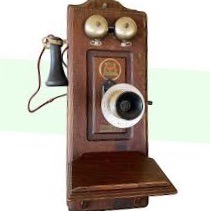
|
We
were still using these unbreakable voice-powered
Carl Ericsson wall telephones that had been built
during the 1890s, at Mangamahu 60 years later.
We could answer calls to our signal ring from
anywhere in the valley, broadcast news to every
home in the valley, make instant emergency calls
or hold group conferences, and there were no
monthly fees. |
Telephone office facilities with the call sign KGR were
added on July 30,
1901. Miss Grace Young was appointed Postmistress on 13
February 1907,
then on October 1, 1912, her sister, Amy Woolven took over. Amy
had married Charlie Woolven, head shepherd at Okirae.
In July 1914, the Post Office was moved to the residence of Henry
Mayo, on the town side of the Kauangaroa bridge.
Mr Mayo built a small
office annexed to his house and his daughter, Claudia Mayo, was
appointed Postmistress. Henry Mayo operated a small accommodation
business. On March 31, 1921, Mr Jim Brown married Miss Mayo and he
took
over the accommodation paddocks and house from his father-in-law.
Claudia resigned as Postmistress on the day she was married and
the Post Office was closed. Settlers were then served by rural
delivery. But the telephone office remained open.
In May 1927, Mr Brown sold his 16 acres to Mr Ted Cranstone. Jack
Carroll and his new bride, Jean, moved into the Brown's cottage
with Mrs Jean Carroll as telephonist.
Requests for a better service eventually saw the telephone office
relocated at the school house with the first teacher at Kauangaroa
School, with Miss Emily Churton as the telephonist.
When Miss Churton resigned in 1940, the telephone office closed
again.
The situation was very frustrating and the village elders made
representations to have the Post Office re-opened. In 1941 the
Post Office opened once more, this time at the residence of Mr
George Matthews, along the Kumuiti Road. His
salary was £30 pa. Marilyn Matthews succeeded her father-in-law in
1966. At that time the Post Office was serving 16 houses and seven
farms. The Post Office at Kauangaroa finally closed on April 30,
1970 as automatic dial phones, rural delivery and faster travel by
road became commonplace.
MANGAWHERO POST OFFICE (1901 - 1915)
There was once a telephone office at Ngaturi.
Records mention its population in 1911 being 49. The school’s name
there was Ngaturi, which could not be used as a name for the post
office there because a Ngaturi post office existed near Pahiatua.
So it was listed as Mangawhero.
Station owner Donald Polson was the telephonist. The office
opened on July 30, 1901 at the "Manurewa" homestead, and closed
February 19, 1915.
William J. Polson was appointed telephonist in 1910, and after the
Mangawhero office closed in 1915 the settlers erected a party line
to
Kauangaroa.
RATAPAPA (Rata Flat) (1894 - 1896)
(Rata Flat is high ground between
Lilburn’s Inzevar farm in the Whangaehu valley, and Tod’s in the
Mangamahu valley. It is now used as an aerial topdressing strip)
There were plenty of problems in the upper reaches as settlers
tried to get the best service for mail and telephone.
Application was made in March 1891 for a post office at Rata
Flat with Edgar
Lewis as Postmaster. The application was approved but, as
the policy was
to have a Maori name where possible, the new office was named
Ratapapa.
Mr. Lewis was the first Postmaster and the office was in his
homestead. He had to carry the mail twice weekly on horseback from
Mangamahu.
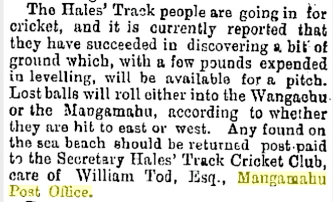 Wanganui
Chronicle - 16 September 1897
Wanganui
Chronicle - 16 September 1897 DELIVERING THE MAIL
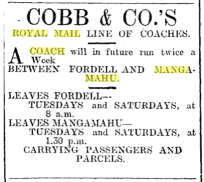
Settlers north of Rata Flat kept requesting a mail service but
were not successful until 1894 when they offered to subsidise a
weekly service. Mr Lewis would carry the mail to Ratapapa on
Saturday. On Sunday he went north along Hales' Track (aka The
Ridge Road) to the Ingram homestead making an open delivery, the
early equivalent of the rural delivery. He returned via the Upper
Whangaehu River Road.
The great mail debate took several years to resolve - how to be
fair to all settlers. In June 1995, the Mangamahu correspondent of
the Wanganui Herald wrote:-
"One of the greatest
troubles in this neighbourhood is the want of a
regular mail service. The mail service as far as Mangamahu
three
times a week is as good as can be expected. Above Mangamahu
there is
a weekly service as far as Mr Ingram's (Manawaimai) about
27 miles
further on.
The last 10 miles of this must necessarily be along Hales'
Track,
but the first part has a choice of three routes—the
Mangamahu
Valley, Hales' Track, or the Whangaehu Valley. Like the
donkey that
starved between two haystacks, not knowing which one to go
to, our
mail travels solemnly along the middle road (Hales'
Track) which is on
a high ridge and has hardly a settler on it for the first
14 miles. It
returns by the same road.
It is absurd that settlers should have to climb about 1000
feet up a ridge
to see if there is any mail for them when they have a road
running right
past their doors.
A much better arrangement might be for the mail to go up by
the
Mangamahu Valley, as far as the road is open, then on to Mr
Ingram's (Bald Hill)
by Hales' Track, returning the same way as far as
Ngamatea and hence
to Mangamahu by the Whangaehu valley road. Or it might go
up the first part by the Whangaehu and return by the
Mangamahu."
The mail service was offered for tenders for 1895-96. Mr T
O'Donovan
secured the contract, and the Chief Postmaster, Wanganui, notified
the GPO that the Ratapapa Post Office was closed.
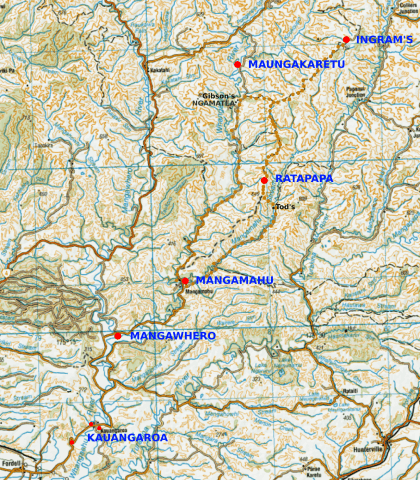
INGRAM'S HOMESTEAD at Bald Hill (1895 - 1904)
When T. O'Donovan secured the mail contract in 1895, it was
decided to
establish a Post Office at the northern end of the service, and on
December
28, 1894, the Chief Postmaster recommended a Post Office for
Ingram's
Homestead with William Ingram as Postmaster.
This opened from January 1, 1895. The name was probably chosen
instead of Bald Hill because of the existence of a Bald Hill Flat
office in
Otago.
The mail contract, 1897-99, was secured by F. A. Allen and for
1900-03 by
James T. Shaw. The contract was relet for 1904-06 to W. Shaw and
the mail run was described as Mangamahu Ingram's via Creek Road
and Hales' Road.
On January 1, 1904, the Upper Whangaehu valley settlers secured a
separate
delivery from Mangamahu — the Mangamahu to Ngamatea Rural Delivery
of today.
Ingram's homestead Post Office closed on February 29, 1904. The
mail
service was relet to W. Shaw Junior in 1907-09 and was described
as
Mangamahu to Waipapa, via Creek and Hales' Roads.
James Shaw carried the mail from Mangamahu up the Ridge Road and
then down to his own place twice a week. One day a week he went up
the
River Road and nine miles along to Bald Hill and home again.
After the death of James Shaw in 1907, his daughter Annie carried
on with the
mail run. In those days the road often became a quagmire in wet
weather.
Nothing daunted Miss Shaw and she became one of the best
remembered personalities in the early years of this century. With
Miss Shaw, hail, rain, mud or flood the mail had to go through and
through it went with this indomitable lady riding side saddle all
the way.
When she found herself with child in 1912, in the middle of
winter, all that she and Bill Gibson knew was that it was
something you had to get married for, and all they knew about
marriage was that it was something done by a minister in a church.
So she and Bill rode up onto Hales Track, down to Mangamahu, then
to the nearest minister, at Matarawa church. Then all the way home
again the same day. 140 kilometres riding sidesaddle - while
pregnant!
See the song Barb Wire
Annie.
MAUNGAKARETU POST OFFICE at Mount View (1913 - 1922)
On October 15, 1912, a request was made for a telephone office at
Mount
View. This was approved but the office was given the name of
Maungakaretu
from the name of the Maungakaretu high point and trig station, a
kilometre sou-west of Ingram's.
The telephone office was opened on January 16, 1913, and closed on
June
20, 1922. No date stamp is recorded in the Post Office archives.
Keith White
remembers that the office provided all facilities except for
posting letters.
THE MANGAMAHU POST OFFICE (1889 - 1988)
The Mangamahu Post Office was opened on January 1, 1889, with Mr
Arthur
Ellis, the proprietor of the Mangamahu Hotel, as Postmaster.
Representa-
tions for an office had been made on November 29, 1887 and again
in October
1888.
On January 15, 1896 the office was moved to the general store
about 50
yards from the Hotel. William Brown was appointed Postmaster. On
October 2, 1896 a request was made re the cost of a telephone line
to Mangamahu and
on April 6, 1900 an application for a telephone office with a line
through
from Kauangaroa was successful.
The telephone office was opened on July 30, 1901, with the call
sign
MAG.
Postmasters-
Arthur Ellis, 1889 (without salary)
William Brown, 1896
William Forsyth, 1902
Justina Forsyth, 1913 (salary £60 pa)
W. Bird, 1915
W. Brown, 1919
Herbert J. Archer, 1920 (salary £102 pa)
Robert C. Cook, 1937
J. J. Gilbertson, 1952
L. Ron Smith, 1960
J. Wills, 1967
Mrs Bev Willis is present Postmistress. (1988)
As early as 1895 the local settlers were complaining about
transmitting
money. They wanted a money order service at Mangamahu instead of
having
to travel 20 miles to Fordell to transact business. For the next
12 years they
continued to petition until they got what they wanted.
By October 8, 1907, a petition, organised by W. Park and R. J. Tod
had been approved by the Department on the recommendation of the
Wanganui Chief Postmaster.
"Herewith a petition from 57
residents of Mangamahu asking for a Post
Office Savings Bank which is now a money order office. The
Postmaster is willing to perform the extra duties providing
the salary is
increased. The district is an important one and Savings
Bank facilities
would be appreciated".
By 1913 the telephone service included the whole of the River
Road. The
cost of connection was charged to ratepayers- five shillings per
mile, minimum
charge £5. The lines were put up out of county funds.
Wanganui
County Council, 6th March 1902
After an inspection visit to the Post Office in 1909 the Chief
Postmaster
reported:-
"The work is carried out on
a counter apart from that at which the store
business is conducted. The arrangements are good for a country
Post
Office. The telephone is placed in a detached room with an
extension to
the store. The room is not sound-proof and the Postmaster
declines
positively to go to any expense in that matter.
The building was under lock when I visited but as there are
few people about the township at any time (off-peak hour?) it
is probable that this precaution does not always prevail and
telegrams could be seen by users of the bureau. In future all
messages will be put under lock as soon as they are disposed
of on the wire.
The settlers have not voiced any grievances and from
experience they
have not been slow in the past in placing their grievances
before the
department. They would prefer a separate permanent office but
this
the present business does not justify."
The question of a separate building for the Post Office arose
again
during a rather stormy period, 1909-13. Mr Forsyth, from the store
absent on extended sick leave. The department recognised Mr Robert
Blythe
as his deputy but Mr Forsyth left Mr Small in charge— Mr Small
lived at the
hotel. The Chief Postmaster was deluged with complaints and
petitions —
telephone conversations were not private, telegrams were seen by
unauthorised persons, the phone not answered.
Toll operators in Wanganui said they had to wait and wait to get
an answer from Mangamahu. Mr T.S Lacy the hotel proprietor seemed
to be allowed to use the toll phone whenever he liked. On one
occasion Mr Lacy and a lady operator argued over who had prior
right to the phone. She maintained that her commercial business
came first—but he would not relinquish the phone.
Both lost their tempers and the local publican was accused.
"You should drink less beer and you might become more civil".
The publican was indignant—he had never been drunk in his life—he
saw too much of that in his line of business!
Mr W. J. Polson (later Sir William Polson) also added his
complaint. He had rung Mangamahu and received no reply. The
telephonist used his discretion when opening up after hours. Poor
Mr Blythe reported that he usually did open up for anyone but in
this case Mr Polson's ring had come through while he was in the
bath.
"Enough is enough", said the locals, "we want a
separate building". Mr Polson as past chairman of the Road
Board offered part of the hall. Mrs J. Morgan indicated that she
was willing to act as operator. The department said the hall was
unlined and unsuitable. Mr Lacy offered a building on his hotel
property — central, suitable and would cost the department only a
peppercorn rent.
Fortunately the department was in no hurry to move or to incur
more
expense. Mr Forsyth's health was still not good so he decided to
sell the store
and the new Postmaster managed to keep the peace. All the same,
opening up
for emergency calls of varying degrees could always put him in a
no-win
situation.
By the 1950s the voice-powered single-wire line, with an earth
return to complete the circuit, and known as "The Spasm" for the
electric shock that its dynamo could give the unwary when the
handle was turned, was perhaps the most over-loaded in the country
with 36 subscribers, and it was left to the local postmaster to
extend the Morse code as best he could.
The
Spasm had restricted hours for
toll calls from 9.00am to 5.00pm with a
close
down for lunch. A toll call enabled the caller to connect to the
Post & Telegraph Department's amplified 2-wire line to town.
There were also 10 locals connected to this party line who paid
a monthly fee. A single long ring (3 rotations of the dynamo
crank handle) summoned a Wanganui operator 24/7.
John Archer recalls—
"My father was the local general carrier (transport
operator) and my mother took all the phone calls requesting
the carting of sheep, cattle, wool, hay, superphosphate, river
metal, farm supplies, a family's furniture, and
(for that surreal month after the Tangiwai disaster) of
"bods" recovered from the river gorges.
"So we had two party-line Carl Ericssons hanging in our
hallway passage; four rather erratic shorts and long sent
her to the Spasm to take a farmer's request, while two
steady longs took her to the Town Phone where dad would be
checking in to see whether anything needed to be brought
back from town.
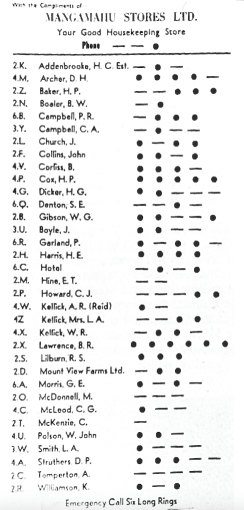
|
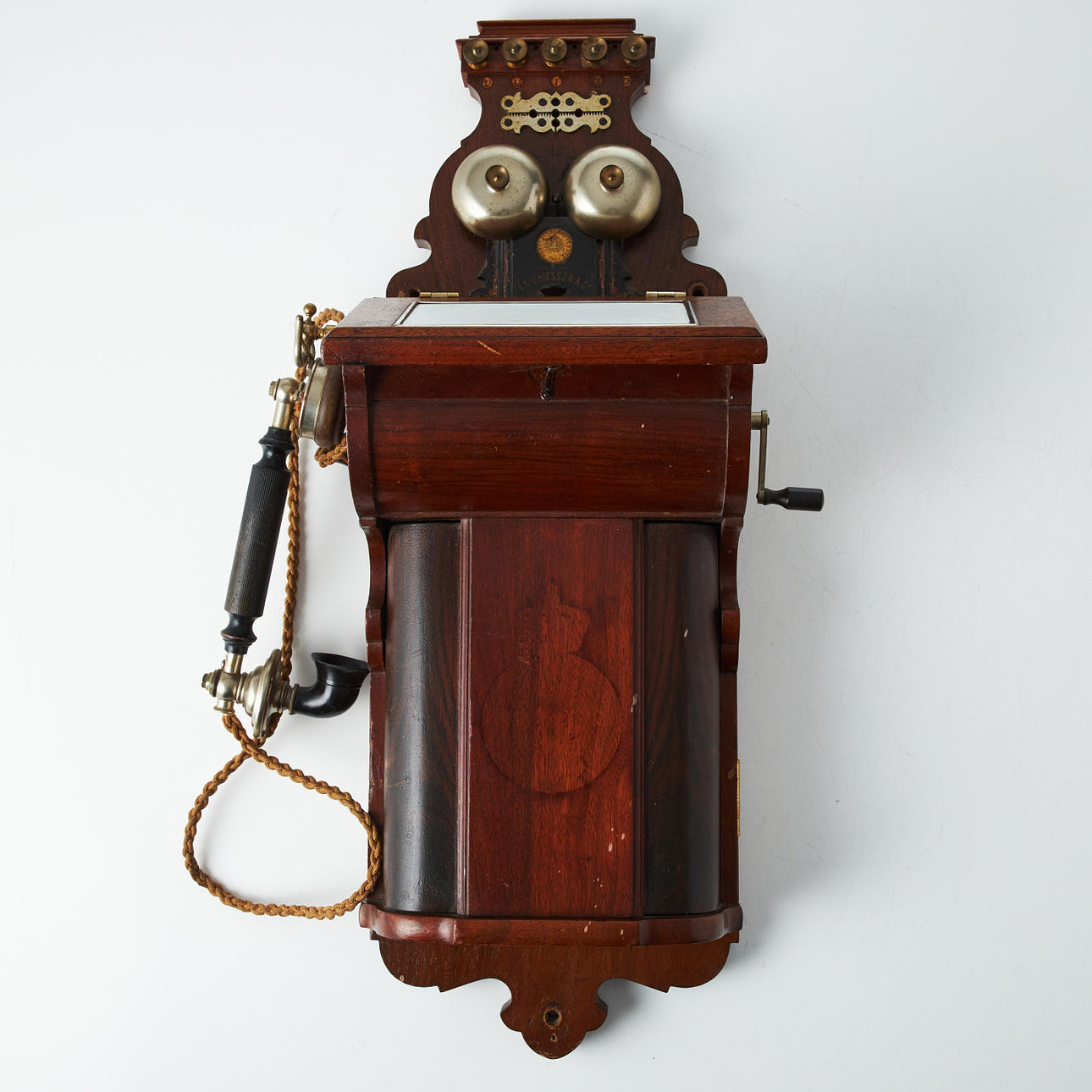
The Carl Ericsson connected to our Town Phone was
a more modern battery-assisted 1900s version,
with miniaturised magnets enabling the
microphone to be in the lightweight
handpiece.
|
Six Long Rings was the
signal for everyone to dash to the phone. That was the ring
for a disaster, a call for help or to announce some momentous
news. Those six rings buzzed up and down the valley frequently
during the war years.
When a young farm-worker's pregnant wife went
into unexpected early labour at 2 am during a winter
storm, and slips had blocked the River Road, the desperate lad
rang six long rings and most of the valley
turned out to help get her through to Wanganui Hospital.
Then when dozens of bodies went swirling past Mangamahu on
Christmas morning after the Tangiwai train disaster, my
father’s six longs initiated a grim 4-week-long recovery
mission, all done without any help from the police or army.
See Pillows of the Dead."
MANGAMAHU'S AUTOMATIC TELEPHONE EXCHANGE
By September 1958 a new automatic phone
service was operating in the
valley. At a ceremony in the Memorial Hall representative farmers
and P&T officials outlined improvements to communications
since the early
days. The new phone set-up was a non-attended unit automatic
exchange
which could channel out-going calls direct to Wanganui toll
boards. Speakers
were Mr R. E. Jack MP, Mr G. Beaglehole, the P&T Divisional
Engineer, and
Mr J. King, his former assistant who had planned the new exchange.
Mr Eric
Hine spoke on behalf of the settlers. Mr Hine had been one of the
prime
movers in the whole project and he said he and the local
Postmaster Mr J. J.
Gilbertson had both looked forward to the day when settlers had
direct
communication to Wanganui.
With the new exchange 51 households now had a 24 hour use of four
lines to the city. Weekend and emergency calls no longer cost an
opening fee or reliance on those who had direct phones. With the
new exchange, 51 households now had a 24 hour use of four lines to
the city.
Weekend and emergency calls no longer cost an opening fee or
reliance
on those who had direct phones.
November 16, 1981, saw another important landmark for upper valley
subscribers the opening of a direct toll free service to Wanganui.
At a
gathering in the Memorial Hall the Minister of Lands and MP for
Waitotara,
Mr V. S. Young, announced the inclusion of Mangamahu in the free
toll
calling area in Wanganui. The minister made the first call to
Wanganui in
front of a delighted audience of about 70 residents. Mr Odell, the
Wanganui
Post Office District Engineer said the cost of the new exchange
equipment
and the cable from Fordell was $242,000. With 52 subscribers from
Mangamahu and 20 from Fordell, also on the exchange, that amounted
to
about $5000 each. In return rentals were increased by $50.
Mangamahu was
the first exchange in Wanganui to have new digital toll equipment
and the
local committee who had worked so long and so hard were proud of
their
achievement.
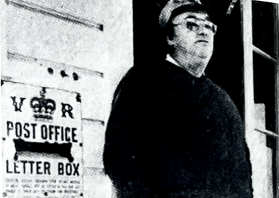 The
Postmaster of the last Post Office in the valley, Mr Jack
Wills, stands at the door of the Mangamahu Post Office which
still displays the V.R. sign.
Victoria Regina—Queen
Victoria—Royal Mail. The
Postmaster of the last Post Office in the valley, Mr Jack
Wills, stands at the door of the Mangamahu Post Office which
still displays the V.R. sign.
Victoria Regina—Queen
Victoria—Royal Mail.
The office officially closed in February 1988. Mail is now
delivered by a rural mail van from Whanganui.
webpage placed on NZFS July 2025
|





 The
Postmaster of the last Post Office in the valley, Mr Jack
Wills, stands at the door of the Mangamahu Post Office which
still displays the V.R. sign.
Victoria Regina—Queen
Victoria—Royal Mail.
The
Postmaster of the last Post Office in the valley, Mr Jack
Wills, stands at the door of the Mangamahu Post Office which
still displays the V.R. sign.
Victoria Regina—Queen
Victoria—Royal Mail.